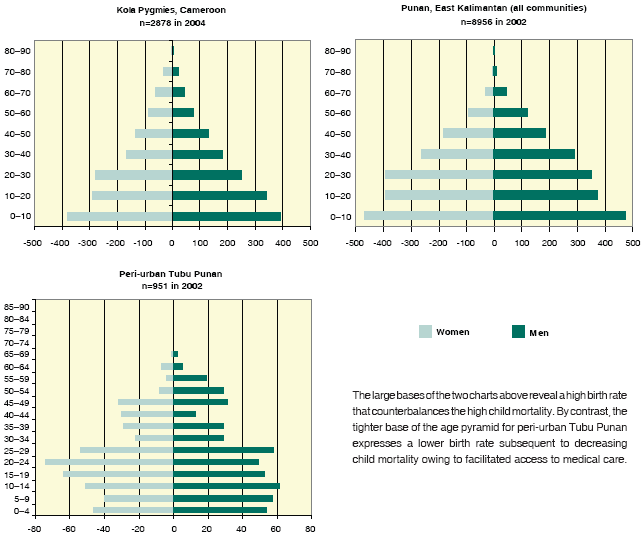E. Dounias and A. Froment
Edmond Dounias and Alain Froment are scientists at the French Institut de Recherche pour le Développment (IRD, formerly ORSTOM). Edmond Dounias is also seconded to the Center for International Forestry Research (CIFOR), Bogor, Indonesia
Diet and health are sensitive indicators of human adaptive responses to change.
The future of forest ecosystems is inseparable from the future of people living in these forests. Accordingly, challenges to the health of both the forest and humans should be investigated jointly. Unfortunately, research devoted to the consequences of biodiversity loss on human health has long focused on the ecological and global systems and persists in neglecting sociological and psychological factors. Environmentalists, ecologists, anthropologists and medical scientists need to sit around the same table to investigate the threats that simultaneously compromise the health of people and the sustainability of their ecosystems. Forest managers and policy-makers need solutions that combine ecosystem management and health-sector interventions to improve human health and well-being while maintaining a healthy ecosystem. The dramatic situation of the few remaining hunter-gatherer groups that still greatly depend on forest resources is emblematic of what is at stake when rapid land use conversion occurs in
forest regions.
Changes in diets and exposure to emerging diseases are sensitive indicators of the ecological and cultural costs that former hunter-gatherers are paying to get their share of modernity. Such indicators illuminate sensitive sociopolitical problems that necessitate concerted and urgent interventions that will respond to both development and conservation interests. Recent hunter-gatherers provide insight into how humans lived when their lifestyles and genetic endowment were more compatible. The cumulative experience of hunter-gatherer societies can be viewed as a benchmark for present-day efforts to promote health and prevent disease, even in the world’s industrialized countries.
This article examines the changes in diet and health that occur when nomadic forest dwellers settle. Examples are drawn from African Pygmy groups such as the Kola, Medjan and Baka of Cameroon, the Aka of the Central African Republic and the Efe and Mbuti of the Democratic Republic of the Congo; and in Asia, the Punan, formerly nomadic forest dwellers of Borneo, in particular the Tubu Punan from the Tubu watershed of East Kalimantan, Indonesia. These formerly nomadic groups were all pushed to settle in permanent villages in the course of the twentieth century, but they still depend on hunting and gathering for their livelihoods and continue to migrate seasonally into the forest in search of forest resources.
| A changing way of life: a work team of Kola Pygmies employed on the Chad-Cameroon pipeline project which crosses over their forest land in coastal southern Cameroon |
 |
F. Nkoumbele |
The number of plant and animal species declines with distance from the equator. This pattern has also recently been documented for parasitic and infectious species. Climatic factors are of primary importance in explaining the link between latitude and richness of human pathogens (Guernier, Hochberg and Guégan, 2004). The high correlation between the diversity of parasitic and infectious diseases and the distribution of tropical humid forests has nourished the persistent belief that forests are inhospitable environments for humans. This perception overlooks, however, the numerous services provided by natural ecosystems to control the emergence and spread of infectious diseases. The protective function of biodiversity, for instance, includes maintaining the balance among predators and prey and among vectors and parasites in plants, animals and humans (Chivian, 2001).
In the developed world, the image of Rousseau’s noble savage living in harmony with his environment has persisted through the centuries, but excessive romanticism has perversely reinforced the conviction among many forest management practitioners and conservationists that the forest is insalubrious for humans. Governing officials may use this view to justify decisions to push forest dwellers outside the forest, supposedly for their own sake.
Nevertheless, the economically, environmentally and politically driven relocation of nomadic people jeopardizes their health conditions by exerting enormous pressure on their natural environment and their cultural systems. Once these groups become sedentary and spend time in larger aggregations, a reservoir that encourages the proliferation and maintenance of a heavy pathogen load is established. In addition, environmental changes in local land use after settlement may combine with global climate alterations to disrupt the natural ecosystem, producing new favourable habitats for vectors and causing an increased risk of transmission of viral and parasitic infections to humans (Patz et al., 2000).
| Delousing is common social behaviour among the Baka Pygmies of southern Cameroon, who temporarily abandon their permanent villages for seasonal camps in the forest; excessive parasites in the camp often provide motivation to move to another place |
 |
E. Dounias |
Nomadism and maintenance of small communities were efficient adaptive responses to high diversity in parasitic and infectious diseases. Formerly nomadic hunter-gatherers lived in small and scattered residential groups within vast and sparsely inhabited forest lands (typically less than one inhabitant per square kilometre). The impermanence of their settlements significantly reduced their exposure to transmissible diseases, airborne and food-borne parasites and faecal pollution. More than the scarcity of food, excessive parasites (fleas, lice and ticks) in the camp provided a strong motivation to move to another place. The death of a member of the community also prodded the community to split and shift to new settlements, reducing at the same time the risk of any lethal factor contaminating other members of the group.
High mobility was facilitated by light burdens and a limited number of surviving children. Groups migrated along extended and linear territorial trails. Regular migrations along these trails not only reduced obstacles to obtaining food – as the hunter-gatherers owned and managed the forest resources within these linear territories, influencing their spatial distribution and density (Dounias 2001) – but also ensured good aerobic fitness, which resulted in low body fat, low blood pressure, low cholesterol levels and prevention of cancer and cardiovascular complications (Eaton and Eaton, 1999).
Although still a matter of controversy, the “Palaeo diet” hypothesis (Wiss, 2006) argues that hunter-gatherers had a healthy food regime that was rich in protein and fibre while low in salt, milk and sugar.
Relatively good fitness was however counterbalanced by relatively high mortality resulting from hunting accidents, falls from honey and fruit trees, snakebites and human conflict. The life span of remaining hunter-gatherers is relatively short: among both the Punan and the Kola Pygmies, people over 65 years of age represent less than 2 percent of the population (Figure). Today’s child mortality is comparable to that reported in Europe a few centuries ago. Short life span and high child mortality are necessary regulating factors in a Darwinian selection process which has ensured a stable demography and the related sustainability of the lifestyle in relation to resource availability (Froment, 2001).
| By living in permanent and more crowded villages, former hunter-gatherers who continue to depend on bushmeat contribute to the diffusion of wild zoonotic diseases, such as Ebola viruses for which gorilla carcasses are reservoirs |
 |
E. Dounias |
| Recent pyramids of age for sedentary Kola Pygmies and Punan and for peri-urban Punan |
 |
TABLE 1. Comparison of parasitic load among different formerly forest-based hunter-gatherers who are currently settled (percentage of infested population)
|
|||||||||||||||||||||||||||||||||||||||||||||||||||||||||||||||||||||||||||||||||||||||||||||||||||||||||||||||||||||||||||||||||||||||||||||||||||||||||||||||||||||||||||||||||
Although a few authors argue that permanent settlement may lead to improved health conditions, there is strong evidence that the shift from nomadic to sedentary lifestyle generally compromises health and well-being. Today, forest populations are mostly farmers. Populations of hunter-gatherers who chose not to shift to agriculture are currently undergoing a sociological transition. They are confronted with demographic expansions that test the carrying capacity of wild edible resources (i.e. the ability of the resource to supply the needs of the consumer group without detrimental effect on the survival of the resource) and force hunter-gatherers to become more sedentary.
Even more threatening than food insecurity to the survival of forest people is the burden of transmissible diseases, which are particularly diverse in moist and hot ecosystems.
The following are some direct detrimental effects on health of the transition to a sedentary way of life.
Cleared lands in which permanent villages are established have a greater range of daily fluctuations in temperature and humidity. The alternation of colder, damper nights with warmer, drier days favours pulmonary pathologies.
Poor sanitation and increased promiscuity bring more frequent contact with human and animal wastes, thus encouraging faecal pollution and increasing parasitic load. Rates of intestinal worms – which cause anaemia and possibly delayed growth, with potentially dramatic consequences for the psychic development of children – have generally risen with a sedentary way of life. However, the sedentary Punan suffer lower rates of parasitic loads than, for instance, many African Pygmy groups, because they have settled along river banks and use rivers for sanitary purposes (Table 1). The rich aquatic fauna ensures a quick and efficient recycling of human waste. Faecal pollution is also a source of bacterial as well as viral infections of the gut, which are major causes of malnutrition, infectious diarrhoea and child mortality.
The wearing of European clothes is strongly encouraged by missionaries and local authorities. In the absence of soap, however, the same clothes are worn dirty until they become dilapidated and thus form a propitious ground for skin diseases.
The risk of contracting zoonotic diseases (diseases transmitted between animals and humans) is elevated in human-inhabited or domesticated forest by the proliferation of rodent-borne disease vectors, as rodents are attracted by domestic garbage and food storage. Frequent contact with a broader range of domesticated animals also raises the probability of pathogen transfer between species. In addition, standing water near the habitat attracts disease-carrying insects.
The emergence of novel zoonotic diseases also becomes more acute with settlement. It is probable that new zoonoses have historically emerged from wildlife many times but failed to spread from the focus of emergence because infected victims living in scattered small hamlets either died or recovered before coming into contact with larger human populations. In modern times, the exponential rise in volume and speed of trade and travel has transformed the epidemiology of emerging infectious diseases, giving them global rather than local importance. By living in permanent and more crowded villages, the former hunter-gatherers who continue to depend on bushmeat – for their own diet and for trade – are more exposed to zoonotic diseases and more likely to contribute to their diffusion. They have higher levels of immunoglobulins in their blood than do agriculturists, which indicate a higher propensity for infection. Infection often leads to malnutrition, which in turn leads to low resistance and thus to further infection, in a vicious circle.
Increased exposure to transmissible diseases (e.g. smallpox, measles, mumps, cholera, rubella, diphtheria and influenza) is associated with dense concentrations of human settlements. In a small, isolated group of people, these pathogens cannot last for long: they race through the group and every person is infected; subjects either perish or develop an enduring immunity, and the pathogen dies out once there is no one left to infect. But wherever humans gather to form a large, concentrated population, these diseases have a sufficient critical mass of inhabitants to permit propagation. The pathogen can persist even after an epidemic, because births and immigration continually provide enough new hosts. The pathogen can prosper indefinitely, and another epidemic may ensue when the number of new hosts has grown sufficiently. In Kalimantan, smallpox caused severe damage among Dayak farmers, but the nomadic Punan had little trouble with it because they practised silent barter to avoid direct physical contact during epidemics: they marked a site where outside traders could deposit their goods, and after the traders were gone they took the goods and left their payment in forest products in the same place (Knapen, 1998). However, today it is no longer possible to resort to protective silent barter or simply to find refuge further inland. Among the various re-emerging infectious diseases occurring today among former hunter-gatherers, tuberculosis is the greatest contributor to human mortality (Barrett et al., 1998).
Low population density and scattered settlements related to the nomadic life effectively protected against vector-borne diseases as human potential hosts were diluted in the environment and thus less visible to vectors. Nomadic Punan and Pygmies were free of malaria since they constantly moved outside the flight range of the mosquito vectors before the malaria-causing parasites (Plasmodium spp.) were able to reproduce. Landscape alterations and developments that accompany the resettlement of nomadic societies, such as the building of roads, timber extraction, mining and agro-industrial plantations, lead to outbreaks of malaria. Temporary workers in areas of high and endemic malaria (e.g. logging camps, agro-industrial villages) sometimes bring back acute forms of Plasmodium spp. which may set off an epidemic. In 2002, this happened in two remote Punan villages of the Tubu watershed when workers returning from Malaysia brought back a severe form of malaria, which killed 28 children (half the population under five years of age) within just a few months.
Industrialization and urbanization, which generally follow economic growth in tropical forests, bring in their wake changes to a population’s diet and nutritional status. The shift to a sedentary way of life affects food availability and distribution and particularly influences children’s nutritional status and health. Resettled peri-urban Punan and sedentary Kola and Baka Pygmies, for example, tend towards an excess intake of energy-dense foods that are rich in fat and free sugars but low in complex carbohydrates. Evidence from epidemiological studies has confirmed a link between such a diet and risks of degenerative chronic diseases of middle and later adult life, particularly cardiovascular diseases and certain types of cancer. Other nutritional disorders such as anaemia, obesity, hypertension, elevated cholesterol levels and diabetes are also appearing among these former hunter-gatherers. Their legendary good fitness is compromised and is currently inferior to that of their farming neighbours.
The body mass index (BMI) – an estimate of the relative percentages of fat and muscle mass in the human body based on an equation relating weight and height – is widely used to assess the nutritional condition of a given population. The indexes of sedentary hunter-gatherers are significantly lower than those of their farming neighbours. However, the BMI of the Tubu Punan who have chosen to stay in the forest (referred to as “remote” in Table 2) is much better than that of their relatives who were encouraged by the Indonesian authorities to settle down near the city of Malinau in the early 1970s (referred to as “peri-urban” in the Table).
 |
Alcoholism is a new rampant social pathology among sedentary Baka villagers |
A. Froment |
|
TABLE 2. Body mass index (BMI) of some former hunter-gatherer societies compared with that of some of their fishing and farming neighbours
|
||||||||||||||||||||||||||||||||||||||||||||||||||||||||||||||||||||||||||||
Modernization – often hastened by government incentives – is generally associated with increased poverty. It contributes to a series of social disorders that indirectly affect the health of forest dwellers (Levang, Dounias and Sitorus, 2004).
Facilitated access to education, markets and trade, job opportunities and local health services is the usual argument for imposing resettlement of hunter-gatherers. However, for several practical reasons these advantages are seldom achieved. Permanent settlements are generally distant from cities, and remoteness from services remains a constraint. For instance, the sedentary Baka Pygmies are much more affected by yaws, a non-venereal form of syphilis, than their farming neighbours (80 percent versus 37 percent, respectively) as a direct consequence of their unequal access to health facilities. Civil servants, many of whom still perceive the forest dwellers as primitive, often refuse to be posted to remote settlements or leave after a few months. For the forest dwellers, the illusion of development gives way to frustration and the feeling of being left behind. Social support such as mutual aid, collective activities and food sharing is in constant decline and is being replaced by more individualistic attitudes.
Stress and depression are fairly common mental diseases, which may lead to conjugal violence and various types of addiction. Heavy alcoholism and smoking are sources of direct intoxication and can be indirect causes of pathologies such as tuberculosis. The conversion of the Punan to Christianity has limited the impact of alcoholism, but emphysema and cancer have increased, probably as a consequence of heavy cigarette smoking (Strickland and Duffield, 1998). The fast-rising prevalence of sexually transmitted diseases such as acquired immunodeficiency syndrome (AIDS) is another sad example of the “fatal attraction of development” (Froment, 2004).
Traditional healing is inefficient in treating diseases that the hunter-gatherers did not meet when they were still nomadic. For instance, compared with their Dayak farming neighbours, the Punan know little about plants with antimalarial properties (Leaman et al., 1995). Healers and wise elders are consequently losing their political influence, and social conflict between generations is becoming more common. A lack of social controls results in dramatic misuse of manufactured medications, such as analgesic pills which are sold without restriction in local retail shops and wide-spectrum antibiotics which are often taken without regard for directions for use. Self-medication and related addictions have become a major health problem among formerly nomadic
societies.
| The younger generation of Punan growing up near the city enjoy electricity and television but suffer discrimination in the job market, and nutritional disorders and increasing social pathologies are symptoms of their ecological and sociocultural maladaptations |
 |
P. Levang |
If forest ecosystems are dynamic, so are the human societies that depend on the forest. Forest dwellers have had to adapt to permanent changes in forest ecosystems. However, the changes that they face today are much more brutal and radical than those they have experienced in the past. With increasingly rapid deforestation, drastic modification of resource availability and the invasive influence of a cash economy, these groups have an increasingly difficult time adapting their social, cultural, economic and political systems. The choices made today by former hunter-gatherer societies are no longer validated by experience, and the shift from a nomadic to a sedentary life style is revealed to be costly in terms of ecological success.
Social change is not necessarily accompanied by biological balance. It may sometimes invalidate defence mechanisms and jeopardize nutritional status. Such biological imbalance may in turn compromise the social and cultural integrity of the society.
However, declining diets and increasing illnesses are only symptomatic warnings of the ecological and sociocultural maladaptations that former hunter-gatherer societies are undergoing. More acute than malnutrition and diseases are the insecurity and discrimination caused by social prejudice. The healthy future of these groups depends on socio-economic and sociopolitical factors such as access to education and the acknowledgement of traditional rights. Medical assistance to cope with the malnutrition and diseases of these people would calm the symptoms, but should not preclude other more wide-ranging interventions, considering the ecological, social, political and economic drivers of change that indirectly affect the health of forest people. Improving their health is not in the hands of medical doctors alone.
![]() Bibliography
Bibliography
Bailey, R.C., Jenike, M.R., Ellison, P.T., Bentley, G.R., Harrigan, A.M. & Peacock, N.R. 1993. Seasonality of food production, nutritional status, ovarian function and fertility in Central Africa. In C.M. Hladik, A. Hladik, O.F. Linares, H. Pagezy, A. Semple & M. Hadley, eds. Tropical forests, people and food. Biocultural interactions and applications to development, pp. 387–402. Paris, France, United Nations Educational, Scientific and Cultural Organization (UNESCO).
Barrett, R., Kuzawa, C.W., McDade, T. & Armelagos, G.J. 1998. Emerging and re-emerging infectious diseases: the third epidemiologic transition. Annual Review of Anthropology, 27: 247–271.
Chivian, E. 2001. Environment and health: 7. Species loss and ecosystem disruption – the implications for human health. Canadian Medical Association Journal, 164(1): 66–69. Available at: chge.med.harvard.edu/publications/journals/documents/chiviancan.pdf
Dounias, E. 2001. The management of wild yam tubers by the Baka Pygmies in Southern Cameroon. African Study Monographs, 26: 135–156.
Dounias, E., Kishi, M., Selzner, A., Kurniawan, I. & Levang, P. 2004. No longer nomadic: changing Punan Tubu lifestyle requires new health strategies. Cultural Survival Quarterly, 28(2): 15–20. Available at: 209.200.101.189/publications/csq/csq-article.cfm?id=1761
Eaton, S.B. & Eaton, S.B. III. 1999. Hunter-gatherers and human health. In R.B. Lee & R. Daly, eds. The Cambridge encyclopedia of hunters and gatherers, pp. 449–455. Cambridge, UK, Cambridge University Press.
Froment, A. 2001. Evolutionary biology and health of hunter-gatherer populations. In C. Panter-Brick, R.H. Layton & P. Rowley-Conwy, eds. Hunter-gatherers: an interdisciplinary perspective, pp. 239–266. Cambridge, UK, Cambridge University Press.
Froment, A. 2004. Do people belong in the forest? Cultural Survival Quarterly, 28(2): 36–40. Available at: 209.200.101.189/publications/csq/csq-article.cfm?id=424
Froment, A., Koppert, G.J.A. & Loung, J.-F. 1993. “Eat well, live well”: nutritional status and health of forest populations in southern Cameroon. In C.M. Hladik, A. Hladik, O.F. Linares, H. Pagezy, A. Semple & M. Hadley, eds. Tropical forests, people and food. Biocultural interactions and applications to development, pp. 357–364. Paris, France, United Nations Educational, Scientific and Cultural Organization (UNESCO).
Guernier, V., Hochberg, M.E. & Guégan, J.-F. 2004. Ecology drives the worldwide distribution of human diseases. PLoS Biology, 2(6): 740–746. Available at: biology.plosjournals.org/perlserv?request=get-document&doi=10.1371/journal.pbio.0020141
Kesteloot, H., Ndam, N., Sasaki S., Kowo M. & Seghers, V. 1996. A survey of blood pressure distribution in Pygmy and Bantu populations in Cameroon. Hypertension, 27(1): 108–113. Available at: hyper.ahajournals.org/cgi/content/full/27/1/108
Knapen, H. 1998. Lethal diseases in the history of Borneo mortality and the interplay between disease environment and human geography. In V.T. King, ed. Environmental challenges in South-East Asia, pp. 69–94. Richmond, Surrey, UK, Curzon Press.
Leaman, D.J., Arnason, J.T., Yusuf, R., Sangat-Roemantyo, H., Soedjito, H., Angerhofer, C.K. & Pezzuto, J.M. 1995. Malaria remedies of the Kenyah of the Apo Kayan, East Kalimantan, Indonesian Borneo: a quantitative assessment of local consensus as an indicator of biological efficacy. Journal of Ethnopharmacology, 49(1): 1–16.
Levang, P., Dounias, E. & Sitorus, S. 2004. Out of forest, out of poverty? Forests, Trees, and Livelihoods, 15(2): 211–235. Available at: www.cifor.cgiar.org/publications/pdf_files/articles/ALevang0501.pdf
Patz, J.A., Graczyk, T.K., Geller, N. & Vittor, A.Y. 2000. Effects of environmental change on emerging parasitic diseases. International Journal of Parasitology, 30(12–13): 1395–1405.
Strickland, S.S. & Duffield, A.E. 1998. Nutrition and ecosystems in Sarawak: the role of the areca nut. Asia Pacific Journal of Clinical Nutrition, 7(3/4): 300–306. Available at: www.healthyeatingclub.com/APJCN/Volume7/vol7.34/Strickland.pdf
Wiss, D. 2006. The Paleolithic diet page – what the hunter/gatherers ate. Internet document. Available at: PaleoDiet.com